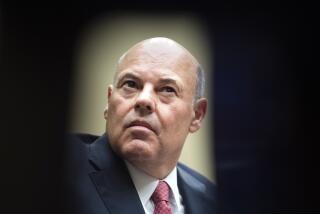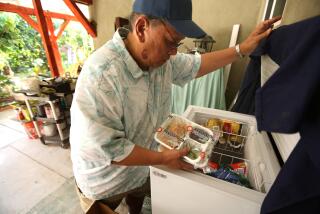Postal Service Gets Stamp of Approval
- Share via
It hasn’t reached the point of staging End-of-Month sales, and you won’t find any Red Tag Specials lying around, but with very little fanfare, everybody’s favorite whipping boy, the U.S. Postal Service, has turned doggedly competitive.
“Competitive”? Against whom?
While the popular image of the Postal Service as a monolithic monopoly is still firmly in place--and in many respects is still valid--funny things have happened to it since it was reorganized in 1971.
Not only have well-organized commercial companies moved in to challenge the Postal Service’s grip on some of its more lucrative fields--notably Federal Express in the overnight mail-delivery service and United Parcel Service in the transport of packages--but also the pressure from Congress to be more efficient, cost effective and sensitive to consumers’ needs has lit a real bonfire under the once-moribund service.
A Ponderous Bureaucracy
It was in the reorganization of 1971 that the Postal Service lost its Cabinet-level position as a department of the federal government and became an independent agency--the only such change so far in U. S. history. But with the heady independence came new responsibilities: primarily that of making the ponderous old bureaucracy actually work.
And who would have thought that the one-time butt of so many bad jokes about its service would be one of the top national winners this year in the customer-service category of the prestigious Society of Consumer Affairs Professionals?
The Postal Service’s accomplishment: the introduction of extended hours at branch post offices. While it hardly seems like an earthshaking innovation--and, in fact, is a “given” in virtually all private businesses--it was a major breakthrough for the giant (784,557 employees) agency, which, since Congress created it in 1789, had been operated almost as rigidly as the Army. It’s no coincidence that the head of the Postal Service (currently Preston R. Tisch) is known as the postmaster general.
“It was a matter of encouraging postmasters to take a look at local needs and make adjustments . . . to recognize the dual-income family, single-parent households, untraditional hours,” according to Ann Robinson, the service’s consumer advocate, who was in Los Angeles to receive the professional society’s award.
All Sorts of Variations
“It was literally the local postmasters’ call in what they wanted to do. So we’ve got post offices that are open 24 hours, opening earlier in the morning and staying open later in the evening, open longer on Saturdays. There are all sorts of variations. Some are staying open one night a week when local stores are open,” said Robinson. Conversely, some branches in commercial centers aren’t opening Saturdays at all but are staying open longer the other five days.
But as in any commercial enterprise, what local officials can do is limited by the bottom line--a postmaster can’t keep his or her branch open 24 hours a day if it’s going to go broke as a result.
Always complicating the Postal Service’s efforts to accommodate consumers is the fact that no other governmental agency--and certainly no commercial enterprise--comes within a country mile of experiencing the sort of public exposure that it does, five days a week, 52 weeks a year. The opportunities for boo-boos are endless.
“We handled 157 billion pieces of mail last year,” Robinson said. “Laid end to end, that’s enough envelopes to reach to the moon and back 20 times. And, in Los Angeles alone, 10 million pieces of mail are handled daily, 3.8 billion annually.”
Nationally, every man, woman and child receives an average of 614 pieces of mail a year and, collectively, we send in 48 million change-of-address cards in the same period.
An M.I.T. Alumna
Robinson, a Sloan Fellow and holder of a master’s degree in management from the Massachusetts Institute of Technology, began as a management intern in 1966 and, before being named the agency’s consumer advocate in 1985, served in a number of management positions including that of executive assistant to the postmaster general from 1983 to ’85.
Few if any entities of such size have a responsibility that--on the surface--can be expressed so simply: Deliver what Consumer A mails in City X to Consumer B in City Y. “Simple” or not, the logistics of accomplishing such a feat has no equal in terms of complexity. Unlike any of its commercial competitors, for instance, the Postal Service doesn’t have the luxury of picking and choosing which economically feasible areas it will serve.
If the tiny post office at Marshbog Lake, Ida., generates only enough postal business in a year to pay the rent on its 300-square-foot office with nothing left over for salaries and for the upkeep of the RFD (rural route) vehicles it operates, too bad. Congress says Marshbog Lake has to have the service.
As a microcosm of the entire postal service, the Postal Service’s Los Angeles district is one whale of a microcosm--a major employer in its own right, with a work force of 11,485, an annual payroll of $342 million and revenues of $376 million a year. And to get letter A to Consumer B, how do you equitably parcel out deliveries among the district’s 2,682 carriers?
L.A.’s Density Varies
“I’m afraid it’s not an exact science,” consumer advocate Robinson admits. “Density is so varied in Los Angeles--from high rises like apartment buildings, condominiums and offices to scattered-out, single-family residential areas--that yardsticks don’t work. The aim is to give the mail deliverers an eight-hour day, including an hour and a half to two hours in the morning so that they can arrange their sequences (sorting the mail according to address). So you’ve got carriers who go no farther than three or four blocks from the branch. You’ve got others whose entire route is a single building.
Robinson added, “In single-family, residential areas, you have ‘park and loop’ routes--the carrier will drive out to the beginning of his route, deliver the mail on foot and then return to the truck for the return to the branch. But in Los Angeles, it’s rare to have any route farther than two miles away from the branch.”
Basically, and perhaps ironically, how much burden a single carrier can handle is measured in linear feet. “Not feet in distances from the branch, or how much walking may be involved, but feet in terms of the three-foot cardboard trays in which mail to be delivered is stacked.
30 Feet a Day
“For instance,” Robinson said, “it may be determined that a carrier can efficiently handle ’30 feet of mail’ a day. That would be the equivalent of 10 three-foot trays.”
In addition to the standard consumer frustrations about mail service--misdirected mail, lost mail, junk mail--there is another problem even more difficult for the postal service to handle: “time-dated mail, which leads to a great deal of consumer irritation--and rightly so--when expectations aren’t met. They know, and expect, Time magazine to be in their box on Tuesday. Sports Illustrated is supposed to be there Thursday and they know, to the day, when their Social Security and retirement checks should be in the mailbox.”
And while so-called “junk mail”--third-class business mail--is on the receiving end of a lot of consumer complaints, the widespread theory that first-class mail subsidizes junk mail simply isn’t true, Robinson added.
“First-class mail is still the highest revenue producer,” she continued, “but our charter mandates that every class of mail has to pay its own way and contribute to the overall institutional costs too. So while business users do get a preferential rate, they do so by doing a tremendous amount of our work for us--delivering it during our off-hours and bringing it to us sorted by ZIP code, carrier code and what-have-you. All the front-end work is taken care of before we even see it.”
In addition to expanded branch-office hours, Robinson said the Postal Service has moved vigorously into the newly competitive communications field in other, less obvious ways. More than 350 collection boxes for prepaid Express Mail have sprung up in Los Angeles as the service fights Federal Express for a bigger share of the overnight delivery market (40% for Federal Express to about 10-12% for the Postal Service).
Computers Cut Waiting
About 80% of the post office retail windows in Los Angeles are now equipped with computerized equipment that reduce waiting lines by making complex weight, distance, insured, registered and certified calculations a matter of tapping a couple of keys.
A new type of mail van, the first of 99,150 vehicles throughout the nation with triple the life expectancy of earlier models, made its appearance here in August. And construction is under way for the largest post office in the West, a 74-acre building with a workroom equal to 10 football fields, set to open in South-Central Los Angeles in 1989. The facility will replace the present Terminal Annex.
Service Improvement
“But we can only keep improving the service,” Robinson emphasized, “if consumers let themselves be heard--either through our customer service cards, which we take very seriously--or by contacting our local consumer affairs representative, Nancy Merriweather, at (213) 586-1460.”
Those who think that the customer service cards (available at every branch office) are simply swept into a corner and ignored should be advised that the expanded branch hours, for which Postal Service was honored last week, was a direct result of a continuing flood of complaints over the agency’s previous inflexible approach to the subject.
Don G. Campbell cannot answer mail personally but will respond in this column to consumer questions of general interest. Write to Consumer VIEWS, You section, The Times, Times Mirror Square, Los Angeles 90053.
More to Read
Sign up for The Wild
We’ll help you find the best places to hike, bike and run, as well as the perfect silent spots for meditation and yoga.
You may occasionally receive promotional content from the Los Angeles Times.






